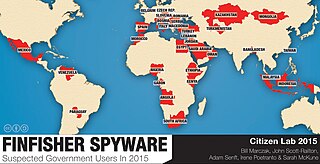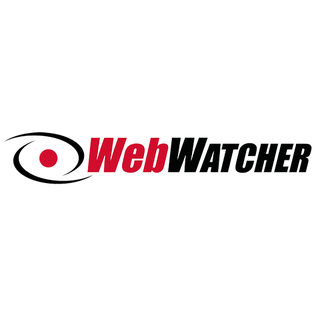Related Research Articles
Spyware is software with malicious behavior that aims to gather information about a person or organization and send it to another entity in a way that harms the user by violating their privacy, endangering their device's security, or other means. This behavior may be present in malware and in legitimate software. Websites may engage in spyware behaviors like web tracking. Hardware devices may also be affected.
Keystroke logging, often referred to as keylogging or keyboard capturing, is the action of recording (logging) the keys struck on a keyboard, typically covertly, so that a person using the keyboard is unaware that their actions are being monitored. Data can then be retrieved by the person operating the logging program. A keystroke recorder or keylogger can be either software or hardware.
Computer and network surveillance is the monitoring of computer activity and data stored locally on a computer or data being transferred over computer networks such as the Internet. This monitoring is often carried out covertly and may be completed by governments, corporations, criminal organizations, or individuals. It may or may not be legal and may or may not require authorization from a court or other independent government agencies. Computer and network surveillance programs are widespread today and almost all Internet traffic can be monitored.
Crimeware is a class of malware designed specifically to automate cybercrime.
Time-tracking software includes programs and applications that allows its users to record time spent on tasks or projects. Multiple industries utilize this type of software, including those that employ freelancers and hourly workers. These include lawyers, freelancers and accountants.

Hardware keyloggers are used for keystroke logging, a method of capturing and recording computer users' keystrokes, including sensitive passwords. They can be implemented via BIOS-level firmware, or alternatively, via a device plugged inline between a computer keyboard and a computer. They log all keyboard activity to their internal memory.
The Computer and Internet Protocol Address Verifier (CIPAV) is a data gathering tool that the Federal Bureau of Investigation (FBI) uses to track and gather location data on suspects under electronic surveillance. The software operates on the target computer much like other forms of spyware, whereas it is unknown to the operator that the software has been installed and is monitoring and reporting on their activities.
Workplace privacy is related with various ways of accessing, controlling, and monitoring employees' information in a working environment. Employees typically must relinquish some of their privacy while in the workplace, but how much they must do can be a contentious issue. The debate rages on as to whether it is moral, ethical and legal for employers to monitor the actions of their employees. Employers believe that monitoring is necessary both to discourage illicit activity and to limit liability. With this problem of monitoring employees, many are experiencing a negative effect on emotional and physical stress including fatigue, lowered employee morale and lack of motivation within the workplace. Employers might choose to monitor employee activities using surveillance cameras, or may wish to record employees activities while using company-owned computers or telephones. Courts are finding that disputes between workplace privacy and freedom are being complicated with the advancement of technology as traditional rules that govern areas of privacy law are debatable and becoming less important.
Employee monitoring is the surveillance of workers' activity. Organizations engage in employee monitoring for different reasons such as to track performance, to avoid legal liability, to protect trade secrets, and to address other security concerns. This practice may impact employee satisfaction due to its impact on the employee's privacy. Among organizations, the extent and methods of employee monitoring differ.
Magic Lantern is keystroke logging software created by the United States' Federal Bureau of Investigation (FBI). Magic Lantern was first reported in a column by Bob Sullivan of MSNBC on November 20, 2001 and by Ted Bridis of the Associated Press.
Cyber spying, cyber espionage, or cyber-collection is the act or practice of obtaining secrets and information without the permission and knowledge of the holder of the information using methods on the Internet, networks or individual computers through the use of proxy servers, cracking techniques and malicious software including Trojan horses and spyware. Cyber espionage can be used to target various actors- individuals, competitors, rivals, groups, governments, and others- in order to obtain personal, economic, political or military advantages. It may wholly be perpetrated online from computer desks of professionals on bases in far away countries or may involve infiltration at home by computer trained conventional spies and moles or in other cases may be the criminal handiwork of amateur malicious hackers and software programmers.
Computer surveillance in the workplace is the use of computers to monitor activity in a workplace. Computer monitoring is a method of collecting performance data which employers obtain through digitalised employee monitoring. Computer surveillance may nowadays be used alongside traditional security applications, such as closed-circuit television.
An anti-keylogger is a type of software specifically designed for the detection of keystroke logger software; often, such software will also incorporate the ability to delete or at least immobilize hidden keystroke logger software on a computer. In comparison to most anti-virus or anti-spyware software, the primary difference is that an anti-keylogger does not make a distinction between a legitimate keystroke-logging program and an illegitimate keystroke-logging program ; all keystroke-logging programs are flagged and optionally removed, whether they appear to be legitimate keystroke-logging software or not. The anti-keylogger is efficient in managing malicious users. It can detect the keyloggers and terminate them from the system.

FinFisher, also known as FinSpy, is surveillance software marketed by Lench IT Solutions plc, which markets the spyware through law enforcement channels.
Retina-X Studios is a software manufacturer company that develops computer and cell phone monitoring applications, focused on computers, smartphones, tablets and networks. The company is founded in 1997 and it is based in Jacksonville, Florida, United States.
HackingTeam was a Milan-based information technology company that sold offensive intrusion and surveillance capabilities to governments, law enforcement agencies and corporations. Its "Remote Control Systems" enable governments and corporations to monitor the communications of internet users, decipher their encrypted files and emails, record Skype and other Voice over IP communications, and remotely activate microphones and camera on target computers. The company has been criticized for providing these capabilities to governments with poor human rights records, though HackingTeam states that they have the ability to disable their software if it is used unethically. The Italian government has restricted their licence to do business with countries outside Europe.

WebWatcher is a proprietary computer and mobile device monitoring software developed by Awareness Technologies. WebWatcher is compatible with iOS, Android, Windows, ChromeOS and macOS operating systems. WebWatcher Mobile records text messages, call logs, web history, photos, and GPS. WebWatcher for PC and Mac features include email & Instant Message monitoring, keystroke logging, web content filtering and monitoring, and screenshot monitoring. Critics have referred to WebWatcher and other similar pieces of software as "stalkerware".

mSpy is a brand of mobile and computer parental control monitoring software for iOS, Android, Windows, and macOS. The app allows users to monitor and log activity on the client device.
Corporate surveillance describes the practice of businesses monitoring and extracting information from their users, clients, or staff. This information may consist of online browsing history, email correspondence, phone calls, location data, and other private details. Acts of corporate surveillance frequently look to boost results, detect potential security problems, or adjust advertising strategies. These practices have been criticized for violating ethical standards and invading personal privacy. Critics and privacy activists have called for businesses to incorporate rules and transparency surrounding their monitoring methods to ensure they are not misusing their position of authority or breaching regulatory standards.
Stalkerware is monitoring software or spyware that is used for cyberstalking. The term was coined when people started to widely use commercial spyware to spy on their spouses or intimate partners. Stalkerware has been criticized because of its use by abusers, stalkers, and employers.
References
- ↑ "What Is Employee Monitoring Software? (with pictures)". wiseGEEK. Archived from the original on 2018-01-02. Retrieved 2018-01-02.
- ↑ "What is employee monitoring?". WhatIs.com. Archived from the original on 16 February 2018. Retrieved 16 February 2018.
- ↑ Ciocchetti, Corey A. (2011). "The Eavesdropping Employer: A Twenty-First Century Framework for Employee Monitoring". American Business Law Journal. 48 (2): 285–369. doi:10.1111/j.1744-1714.2011.01116.x. ISSN 1744-1714.
- 1 2 Spitzmüller, Christiane; Stanton, Jeffrey M. (June 2006). "Examining employee compliance with organizational surveillance and monitoring". Journal of Occupational and Organizational Psychology. 79 (2): 245–272. doi:10.1348/096317905x52607. ISSN 0963-1798.
- ↑ Gilliland, Donald (2021-07-24). "Warning: Your boss is probably spying on you — and it could be bad for your health". The Hill . Retrieved 2021-12-22.
- 1 2 3 Cole, Samantha (2021-12-08). "Workers Are Using 'Mouse Movers' So They Can Use the Bathroom in Peace". Vice . Retrieved 2021-12-22.
- 1 2 Cyphers, Bennett; Gullo, Karen (2020-06-30). "Inside the Invasive, Secretive "Bossware" Tracking Workers". Electronic Frontier Foundation . Retrieved 2021-12-22.
- 1 2 Klosowski, Thorin (2021-02-10). "How Your Boss Can Use Your Remote-Work Tools to Spy on You". The New York Times . Retrieved 2021-12-22.
- 1 2 Crispin, Jessa (2021-09-16). "Employers are spying on us at home with 'tattleware'. It's time to track them instead". The Guardian . Retrieved 2021-12-22.
- ↑ ‘Bossware is coming for almost every worker’: the software you might not realize is watching you The Guardian. 2022.
- ↑ Scherer, Matt (2021-09-16). "Strategies to Tackle Bossware's Threats to the Health & Safety of Workers". Center for Democracy and Technology . Retrieved 2021-12-22.
- ↑ "Workplace monitoring platform Aware takes in $60M". VentureBeat. 2021-10-13. Retrieved 2022-08-09.